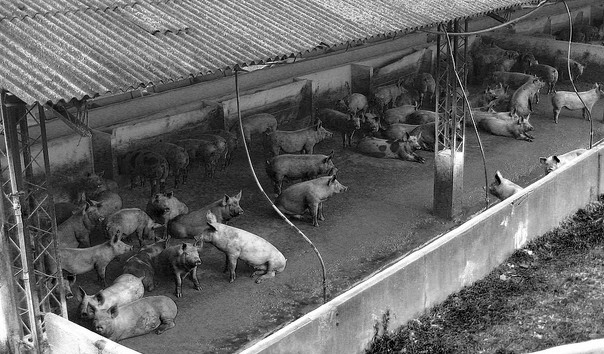Podcast: Play in new window | Download
Subscribe: RSS

Confined, crowded and stressed meat animals like these pigs are given 29 million pounds of antibiotics every year in the US, 80 per cent of the available supply, to make sure they grow. As a result, the seven million pounds administered to humans are becoming less effective. (Photo by Victor Sounds/Flickr)
This summer, the US Department of Agriculture received a report it had commissioned on the rise of infectious bacteria that are resistant to antibiotics. The report — not a study, but a survey of existing studies — warned of a “growing public health concern worldwide” as more and more people are sickened and killed by infections against which modern medicines are helpless. (Just one of them, MRSA, now kills more people every year than AIDS.) And it was a powerful indictment of industrial agriculture’s role in creating these so-called “superbugs.” So the USDA did just what you would expect the government regulator of industrial agriculture to do: it buried the report.
The USDA first posted the report on its website, pointing out that the studies referenced in the report were all from “reputed, scientific, peer-reviewed and scholarly journals.” Obviously, that was written by a low-level staffer who is not in touch with the big picture, and who still believes in “science.” But before we review the short life and nasty end of the report, let’s review what was in it.
The report summarized 63 scholarly papers that looked at the effects of administering large quantities of antibiotics to animals being raised for food in confined, crowded, stressful conditions with unnatural diets. The antibiotics are given not to make sick animals well, but to keep all the animals well enough to put on weight — that means profit — and make it to slaughter. It is pretty well known now that the practice kills off bacteria that are not naturally resistant to the antibiotic; those that survive, thrive, and soon the whole population consists of superbugs that, when they infect humans, cannot be killed.
Just in outline, that sounds bad. But this report got more specific about how bad:
Antimicrobial-resistant strains of foodborne pathogens are widespread throughout the world. Most of these resistant pathogens … acquire their resistance in food animal host before they transmit and infect human beings via the consumption of contaminated food. Therefore, foods of animal origin are frequently associated with antimicrobial-resistant foodborne disease outbreaks. Some foods that have been associated with antimicrobial-resistant infections and outbreaks include:
- Chicken
- Beef
- Pork
- Dairy products
- Salad vegetables
Hair on fire yet? If not, read the entire report, “A Focus on Antimicrobial Resistance,” preserved by the grace of the Google search cache. Don’t miss this conclusion:
“The increasing rate of [antibiotic resistance] has raised the concern that we may enter the ‘post antibiotic era’ where no effective antibiotics for treating several life-threatening infections would be available.”
Days after it appeared on the USDA website, and in a matter-of-fact report on the Dow Jones Newswires, the industry cleared its throat. The chief veterinarian of the National Pork Producers Council, Liz Wagstrom, opined (for the journal National Hog Farmer): “We find it very disappointing that a research assistant at a university, who is not an Agricultural Research Service scientist can develop and post such a review without it going through an agency or peer review process.” Wait a minute. Only an Agricultural Research Service scientist can report what scientists all over the world are finding? And why does a report that quotes only peer-reviewed studies have to be peer reviewed?
Never mind, you could almost hear the yelp from USDA at the touch of the lash. And you could see it, in the form of a new disclaimer that appeared in bright red over the study on the website: “This technical review was written by a university cooperator. This review has not been peer reviewed. The views expressed in this publication do not necessarily reflect the views of the United States Department of Agriculture.”
A few weeks later, the report vanished altogether. And the USDA ordered the researcher who wrote it never to speak to the news media about it.
It just got peer reviewed.
I’ve read of a special form of healing involving the use of ultraviolet light, known currently as ‘photoluminescent therapy’ though it has also been given other names. It involves extracting a small quantity of blood from the patient, irradiating the blood with UV light and re-introducing it back into the patient’s body, though a modern variant of this treatment dispenses with the extraction of blood, employing instead a handheld device for shining UV light under the tongue. This form of treatment has been claimed to vastly augment the body’s immune system so that even otherwise lethal diseases such as botulism are successfully cured. There are supposed to be many research articles documenting its success in treating numerous medical cases. More details can be found in William Campbell Douglass’ book ‘Into the Light’ and at the website harrismed(dot)com.
This form of healing may therefore be our best hope against the superbugs bred by aberrant modern farming practices, assuming the veracity of all the claims regarding it. Unfortunately it is currently being pooh-poohed by the medical establishment apparently.
Fascinating information. Thanks.